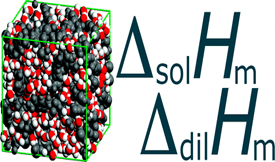
Energetics of Aqueous Solutions of the Ionic Liquid 1-Ethyl-3-methylimidazolium Ethylsulfate
J. Phys. Chem. B 2010, 114, 13179–13188. DOI: 10.1021/jp1067473
Abstract
The energetics of aqueous solutions of the ionic liquid (IL) 1-ethyl-3-methylimidazolium ethylsulfate in the concentration range m < 165 mol/kg was analyzed on the basis of the enthalpies of solution of the IL in water (ΔsolHm) and the enthalpies of dilution (ΔdilHm) of solutions with different IL concentrations. The data were both obtained experimentally, by calorimetry, and theoretically, by using Molecular Dynamics (MD) simulations. Particular attention was given to the low-concentration range (m < 5 mol/kg), which had not been covered in previous experimental studies of this system. The dependence of ΔsolHm from the molality of the IL observed within this m < 5 mol/kg range could be fitted to a fourth-order polynomial with an average relative deviation of ∼0.13%. This polynomial function shows a minimum of ΔsolHm at m ≈ 0.6 mol/kg (or a molar fraction xIL ≈ 0.01) that could be approximately captured by the MD simulations performed in this work but not through extrapolations based on previously reported experimental or simulation data. The decomposition of our MD simulation ΔsolHm results in contributions from different types of interaction (IL−IL, H2O−H2O, and IL−H2O), indicated that the minimum essentially results from two opposite effects: the differences between the IL−IL and H2O−H2O interactions in the solution and in the pure liquids are both positive and increase with the dilution of the IL, while the contribution of the IL−H2O interactions (that is only present in the solution) is negative and decreases with the IL dilution. It was also found that the observed trends in ΔsolHm are dominated by electrostatic rather than dispersion interactions.
Return Previous Next